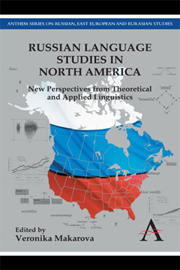Book contents
- Frontmatter
- Contents
- List of Tables and Figures
- Introduction
- Part One Language Structures and their Interface
- 1 Phonetics. Tracing Emotions in Russian Vowels
- 2 Phonology. Vowel–Zero Alternations in Russian Prepositions: Prosodic Constituency and Productivity
- 3 Morphology and Lexicology Interface. Latest Russian Neologisms: The Next Step towards Analytism?
- 4 Syntax. Bi-nominative Sentences in Russian
- 5 Psycholinguistics. The Effect of Grammatical Gender in Russian Spoken-Word Recognition
- Part Two Applied Linguistic and Sociolinguistic Analysis
- Afterword
- Index
3 - Morphology and Lexicology Interface. Latest Russian Neologisms: The Next Step towards Analytism?
from Part One - Language Structures and their Interface
Published online by Cambridge University Press: 05 November 2012
- Frontmatter
- Contents
- List of Tables and Figures
- Introduction
- Part One Language Structures and their Interface
- 1 Phonetics. Tracing Emotions in Russian Vowels
- 2 Phonology. Vowel–Zero Alternations in Russian Prepositions: Prosodic Constituency and Productivity
- 3 Morphology and Lexicology Interface. Latest Russian Neologisms: The Next Step towards Analytism?
- 4 Syntax. Bi-nominative Sentences in Russian
- 5 Psycholinguistics. The Effect of Grammatical Gender in Russian Spoken-Word Recognition
- Part Two Applied Linguistic and Sociolinguistic Analysis
- Afterword
- Index
Summary
Introduction
This chapter examines Russian neologisms (new words) related to modern technology, the Internet and other forms of media, looks at their orthographic representations and discusses their effect on the Russian morphology, morphosyntax and the tendency towards increased analytism. The sample of Russian neologisms is taken from two major sources: neologism dictionaries and Internet texts. The dictionary entries in the study come from neologism dictionaries published at the end of the twentieth and the beginning of the twenty-first centuries (Zaxarenko, Komarova and Nečajeva 2003; Efremova 2000; Lopatin 2002; Skljarevskaja 1998). These dictionaries serve as a valuable source of information on vocabulary borrowed during the first decade of computerization and popularization of the Internet in Russia. The second source of data in the study is Russian-media texts taken from the Internet: popular blogs, online newspapers and other sites. Internet sites provide us with the most recent borrowings and with illustrations of the use of neologisms found in neologism dictionaries. The Internet data were analyzed with a text parsing program created specifically for this study. The program searched Russian language Internet sites for text contexts and various orthographic representations of new loan words.
The study excluded emails and informal chat rooms so as to restrict the analysis to the most common loan words and discard occasionalisms. The study analyzes the structure of neologisms borrowed into Russian from English and other languages and discusses their impact on the morphological and orthographic structures of contemporary Russian.
- Type
- Chapter
- Information
- Russian Language Studies in North AmericaNew Perspectives from Theoretical and Applied Linguistics, pp. 71 - 84Publisher: Anthem PressPrint publication year: 2012
- 1
- Cited by



